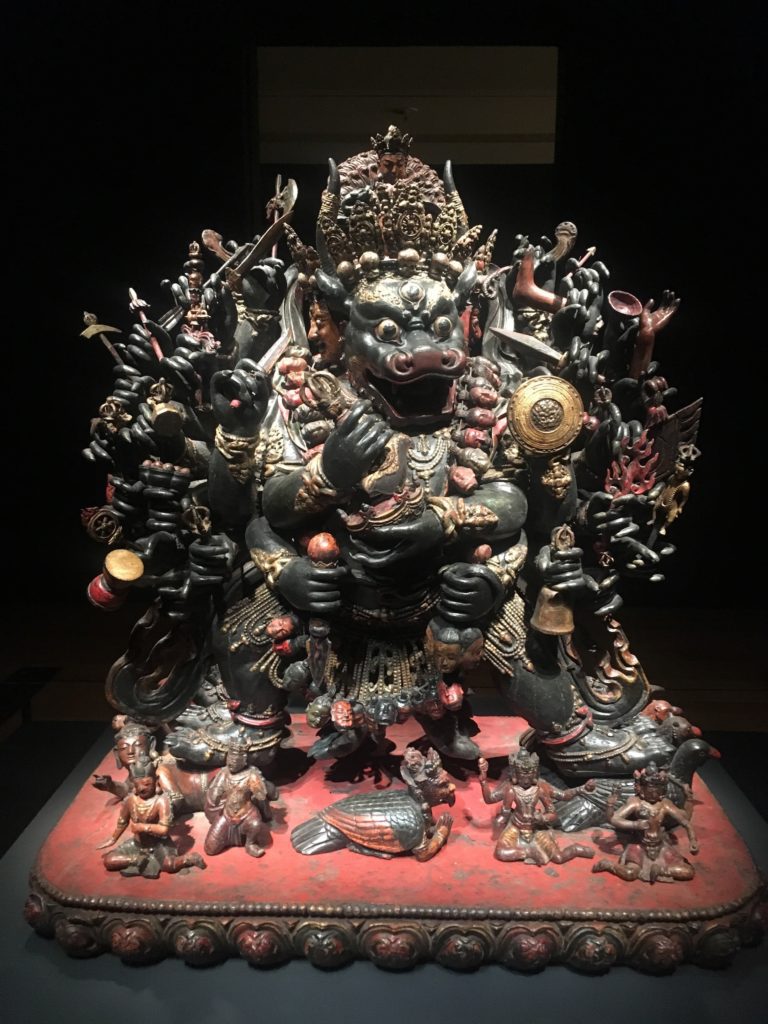A Journey into Tibetan Art in Richmond
By • July 25, 2019 0 1297

At the start of the exhibition “Awaken: A Tibetan Buddhist Journey Toward Enlightenment,” on view through Aug. 18 at the Virginia Museum of Fine Arts in Richmond, is a card table-sized sand painting made last May by Tibetan monks. Nearby, a time-lapse video of its creation runs continuously.
The monks will be back to obliterate their painstaking effort on Saturday, Aug. 3, at 11 a.m. Like all such “paintings,” it is meant to be as ephemeral as human existence.
The colorful and detailed image is a mandala (the Sanskrit word for circle), a two-dimensional representation of the cosmos on which one focuses during meditation. The premise of “Awaken” is that museum visitors will feel that they are entering one of these virtual environments as they proceed through the show’s sequential galleries of Tibetan Buddhist paintings, sculptures, decorative objects and artifacts.
The numerous works on view are exquisite and remarkably varied. The VMFA has one of the best public collections of Tibetan art in the country. (Other exceptional collections on the East Coast are at the Newark Museum in New Jersey, the Rubin Museum in Manhattan and the Jacques Marchais Museum on Staten Island.) To the VMFA’s rich holdings have been added pieces from the Asian Art Museum of San Francisco and borrowings from other museums and private collections.
By framing the show as a journey — rather than organizing the works chronologically or by medium or region of origin (Tibet, Nepal, China, India, etc.) — the curators have sought to remove barriers that make it difficult for museumgoers to fully appreciate art so intimately connected with what is, to most, an unfamiliar if not incomprehensible culture.
Created and viewed in shrines, temples and monasteries, the scrolls of cotton or silk known as thangkas and the statuettes of stone, wood and metal were not meant to be admired for their craftsmanship or for the precious materials their anonymous makers employed. To some extent comparable to the carvings, mosaics and stained glass of medieval cathedrals, they were (and are) objects of devotion, aids to followers of Vajrayana Buddhism, the esoteric, tantric branch of Buddhism that developed in the Himalayas over many centuries as a faster path to enlightenment.
Immersive techniques help to dissolve the antiseptic setting of museum walls and display cases. Early on, one walks through a room with a video and sound montage representing the cacophony of contemporary life. Beginning in the first large gallery, one hears recorded chanting and bells.
At the midpoint, after an introduction to Tibetan Buddhism and a rundown of the required preparations, tools, musical instruments, weapons and allies for one’s journey, a map keyed to a mandala made at the Ngor Monastery between 1650 and 1750 is provided for the next series of galleries. Each represents a stage of penetration, past walls of fire and skulls, funerary grounds and fierce guardians.
The lighting grows dimmer as one proceeds, until there in semi-darkness stands the yidam, the deity at the center of the mandala: a spectacular — and heart-stopping — wooden statue of Vajrabhairava, who faces down Death on our behalf.
The exhibition also includes a gallery of “yab-yum” paintings and sculptures, which depict (scandalously to prudish Western eyes) the sexual union of a male deity and a female deity, said to symbolize the union of compassion and wisdom. In addition, several contemporary works inspired by traditional Tibetan art are inserted at various points.
Mounting an exhibition that can satisfy a broad range of museumgoers, from connoisseurs of Asian art to yoga-mat commuters, is a tall order, but the curators of “Awaken” appear to have succeeded. True, it is somewhat incongruous to tell visitors to “power down” while handing them an audioguide, but the text, both printed and recorded, is generally at an impressive intellectual level, worthy of the gorgeous, imaginatively assembled art on view.

Bone apron (detail), 17th century, Tibetan. Photo by Richard Selden.
Virginia Museum of Fine Arts
200 N. Arthur Ashe Boulevard
Richmond, VA 23220
804-340-1400
Open daily 10 a.m. to 5 p.m.; Thursday and Friday until 9 p.m.
Free admission
“Awaken: A Tibetan Buddhist Journey Toward Enlightenment”
Through Aug. 18
Tickets: $15; $12 seniors; $10 students and ages 7 to 17; free age 6 and under

